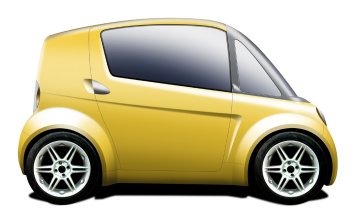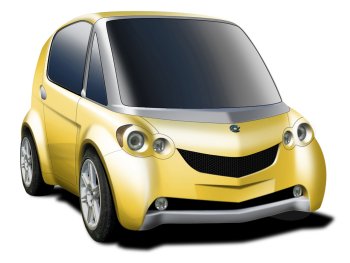|
The result of
the research done on innovation of the form, technology, materials, and
propulsions, Carcerano presented a new concept of city car, called
"Sonny", which was shown in prototype form for the first time during the recent
the Bologna Motor Show.
“Sonny“, which means, among a variety of
definitions, “friend“, "brother” in American English, here takes on the meaning
of “ road companion “, as it is an Urban Car able to communicate perfectly with
the urban context in which it travels. All thanks to Communications Technology (an Intelligent Controls System, ICS, comprised of sensors, electronics and
advanced software, allowing the car to move in complete security within the
urban network), and thanks to the architectural design of the vehicle itself,
with its reduced dimensions and wide glass surfaces that communicate openly with
the city as it almost becomes an integral and active part of it. The electronic control of the on-board
control features increases the driver’s and the passengers’ security as well as
that of the pedestrians, thus contributing to the reduction of car accidents and
levels of stress produced by traffic.
Sonny was conceptualised as a
research project in order to help us understand just how much this type of
solution to traffic could be integrated within the city, specifically in the
case of Turin’s old town centre, and permitting the investigation of its
possible impact on the urban context, as well as research on new tools and
materials to fight against environmental and acoustic pollution. With this
regard in mind, the Carcerano Research Centre also participates in the “Pre-competitive Development Project“ and the Industrial Research Project “ on a
national level concerning “Integrated Methodologies of Design for the
Innovation of Style and Technology of Motor Vehicles within a Virtual
Environment“. This study places particular attention on expired vehicles
that present little possibilities for recycling, re-use and energy recovery. A
true challenge which intends the necessity to intervene at the moment of the
vehicle’s retirement, but also at a much earlier time, that is, during design
and production.
Sony Carcerano thus becomes the object of study and laboratory research in constant
evolution. It is the expression of experimentation of style, of technological
innovation and most of all, it is the expression of our effort to protect the
environment.
|

 |
|
Sonny
was conceptualised as a research project in order to
help us understand just how much this type of
solution to traffic could be integrated within the
city, specifically in the case of Turin’s old town
centre, and permitting the investigation of its
possible impact on the urban context, as well as
research on new tools and materials to fight against
environmental and acoustic pollution. |
|
 |
|
|
 |
|
The
result of the research done on innovation of the
form, technology, materials, and propulsions,
Carcerano presented a new concept of city car,
called "Sonny", which was shown in prototype form
for the first time during the recent the Bologna
Motor Show. |
|
 |
|
|
The main guidelines for this project have been: to create a
vehicle able to transform itself depending on the user’s wishes; to lower
maintenance and consumption costs; and to obtain, as a result, a vehicle with
low negative impact on the environment.
CARCERANO SONNY-
CHARACTERISTICS
Interiors: disposes of
four actual seats and offers a habitability which clearly
represents one of its strong points, considering its external dimensions.
Compact and inhabitable, it responds to the essential requisites of small city
cars. Equipped with ample on-board inhabitable space, seats that gave way to
spaciousness and accessible and practical accommodating spaces. Its great
vertical posterior struts create a back zone that is incredibly private and
cosy.
Exteriors:
Its style combines fluid lines and generous
spaces. The front end is rounded as the convex form attracts the eye of the
beholder. The rear door (hatchback) has been conceived to give the maximum
flexibility of use to the trunk compartment. The illumination features define
and recall the perception of the form with their simple geometric lines.
Comfort:
the general perception of the Sonny
concept
is that of a most ample interior structure. The wide glass surfaces only serve
to increase this sensation of spaciousness. The dashboard, with its easy to
understand controls, immediately puts one at ease.
The dynamics of the car, mode of driving and
comfort aspects, are exalted by the automatic gear-change.
Agility of use:
with its contained dimensions, its exceptional
vaulted diameter, and its automatic gear-change, Sonny offers a
strong sense of agility. The Carcerano Concept Car also foresees hybrid
motors and cars composed of the most modern technology.
Safety:
Foresees the use of active and passive safety
systems. The active safety includes ESP and ABS with Brakes Assistance, and an
intelligent controls system, ICS, constituted of sensors, electronics and highly
advanced software permitting Sonny to move about with extreme
safety within the urban network. The passive safety features comprise elements
that protect the driver and the passengers, such as a safety shell, driver and
passenger airbags, and safety integrated seats.
Ecology:
The idea to build an automobile that respect
the environment is at the very foundation of the Carcerano Sonny project: the
synthetic panels are recyclable and the light-weight material used helps limit the
weight of the vehicle thus contributing to a reduction in energy consumption and
costs.
|
|
|
|